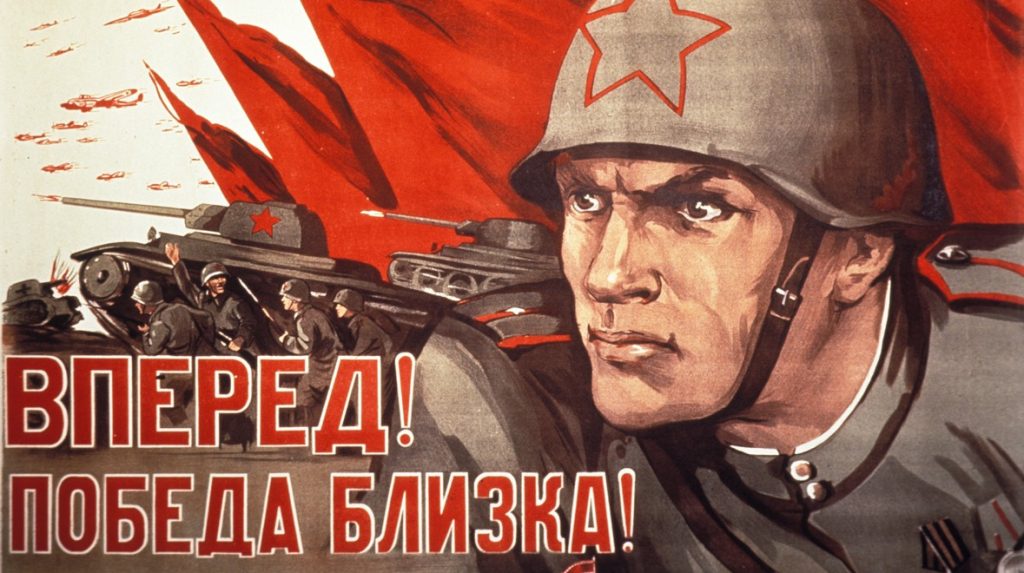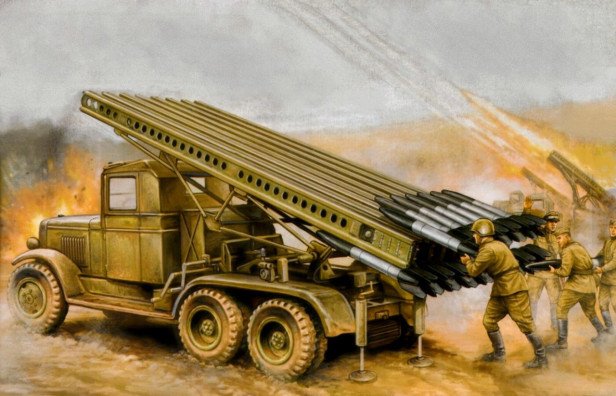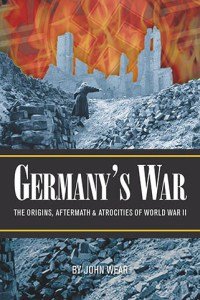By John Wear
Soviet Preparations for Offensive War
In the years 1937-1941, the Soviet Army grew five-fold, from 1.1 million to 5.5 million.[1] An additional 5.3 million people joined the ranks of the Red Army within one week of the beginning of the war. A minimum of 34.5 million people were used by the Red Army during the war.[2]
This huge increase in the size of the Soviet Army was accomplished primarily by ratification of the universal military draft in the Soviet Union on September 1, 1939. According to the new law, the draft age was reduced from 21 to 19, and in some categories to 18. This new law also allowed for the preparation of 18 million reservists, so that the Soviet Union continued to fill the ranks of the Red Army with many millions of soldiers as the war progressed.[3]

Several age groups were drafted into the Red Army at the same time; in essence, all of the young men in the country. The duration of army service for the majority of the draftees was two years, so the Soviet Union had to enter a major war within two years. If war did not start by then, all of the young people would have to go home on September 1, 1941, and then there would be almost nobody left to draft. It is extremely difficult to maintain an army of this size without a war; the army does not produce anything and consumes everything produced by the country. Stalin knew when he established the draft that in two years, in the summer of 1941, the Soviet Union must enter into a major war.[4]
On January 11, 1939, in preparation for war the Soviet Union created four new People’s Commissariats: one for the shipbuilding industry, one for weapons, one for the aviation industry, and one for ammunition. The Shipbuilding Commissariat undertook strictly military projects from the moment of its founding. Also, on May 25, 1940, the following numbers of civilian ships were handed over to the military: 74 to the Baltic fleet, 76 to the Black Sea fleet, 65 to the North fleet, and 101 to the Pacific fleet. By June 22, 1941, the Soviet Union also possessed 218 submarines in its ranks and 91 more in shipyards, all of which matched up to the best world standards.[5]

Stalin’s more than 200 submarines and the rest of his navy were ineffective at the start of the war because it was an attack fleet. Stalin’s navy was built for aggressive war and could not be used effectively in a defensive war. Entirely different ships with entirely different characteristics are needed for defense: submarine hunters, picket boats, minesweepers, and net-layers. The armament of the Soviet ships was also designed exclusively for participation in a war of aggression. While armed with powerful artillery, mine, and torpedo equipment, Soviet ships had quite weak anti-aircraft armament and defenses.

Soviet generals had planned to begin the war with a crushing surprise attack against the enemy’s air bases that annihilated his aviation. When Germany attacked first, the Soviet navy’s lack of anti-aircraft defenses was a major liability. The Soviet war effort was also hurt by the fact that all of the navy’s reserves of shells, mines, torpedoes, and ship fuel had been transported to the German borders and were quickly seized by the Germans when they invaded the Soviet Union.[6]
The Ammunition Commissariat was created as a separate ministry to take care exclusively of the production of ammunition. This ministry had to determine where to locate all of the new factories that would be producing shells, gunpowder, cartridges, missiles, and other weapons. If Stalin had planned to conduct a defensive war, the new ammunition factories would have been built either behind the Volga River or even farther inland in the Ural Mountains. But no defensive options were ever discussed. Since Stalin planned to conduct an offensive operation into a war-devastated and weakened Europe, all of the new ammunition factories were built near the western border regions of the Soviet Union.
The Soviet Union lost almost all industry capable of producing new ammunitions at the beginning of the war. From August to November 1941, German troops took over 303 Soviet ammunition factories as well as mobilization reserves of valuable raw materials located in those factories. These factories produced 85% of all output from the Ammunition Commissariat. All of these resources went to Germany and were used against the Red Army. The Red Army also lost an unthinkable amount of artillery shells in the border regions of the Soviet Union at the start of the war. However, Stalin’s prewar potential was so great that he was able to rebuild his ammunitions factories behind the Volga River and in the Urals, and produce all of the ammunitions needed to defeat the German army.[7]
The seizure of Stalin’s supplies was a tremendous benefit for Germany, but Hitler needed to shift Germany’s own industry to a wartime regime. Hitler waited until January 1942 before he made the decision to gradually begin the shift of industry from a peacetime to a wartime regime. Stalin, on the other hand, began setting Soviet industry on a wartime regime back in January 1939. Despite losing 85% of the ammunitions of the Ammunition Commissariat, the Red Army used 427 million shells and artillery mines and 17 billion cartridges during the war. To this one can add innumerable hand grenades, land mines, and air bombs. Imagine what the outcome of World War II would have been if Stalin had been able to use 100% of his ammunitions arsenal.[8]
In the summer of 1940, Stalin brought Estonia, Latvia, and Lithuania into the Soviet Union, and concentrated his forces in that region on the border of Eastern Prussia. The occupation of these Baltic countries by the Red Army made sense only if there were plans for an aggressive war against Germany. The Red Army transferred its air bases to the very front edge of the German border. From the air bases in Lithuania the Soviet air force could support the advance of Soviet troops to Berlin. The Soviet navy also transferred primary forces and reserves to naval bases established in Tallinn, Riga, and Liepāja. Since it was a short distance from Liepāja to the routes taken by German vessels carrying ore, nickel, and wood to Germany, a strike from this area could be sudden and devastating.[9]

The Soviet Union annexed Bessarabia and Northern Bukovina in 1940. From Bessarabia the Soviet air force could keep the Romanian oil industry, which was the main supplier of oil to Germany, under constant threat. Northern Bukovina was needed because it had a railroad of strategic importance that had a narrow gauge track which enabled it to be used by railroad cars from all over Europe. The Soviet Union used a broad gauge track. Soviet locomotives and trains could therefore not be used on the narrow gauge tracks of Central and Western Europe. In a Soviet invasion of Europe, Stalin would need many locomotives and trains with a narrow gauge to supply his troops that were quickly moving westward.
During the course of the Bessarabia campaign, the Soviet Union captured 141 locomotives, 1,866 covered train cars, 325 half-covered train cars, 45 platforms, 19 cisterns, 31 passenger cars, and two luggage cars. But this was not enough for Stalin. At the Soviet-Romanian talks in July 1940, Soviet representatives demanded that Romania return all captured mobile railroad units. On July 31, 1940, Romania agreed to transfer 175 locomotives and 4,375 cars to the Soviet Union by Aug. 25, 1940. None of these trains would have been needed in a defensive war. Stalin needed these trains seized in Bessarabia and Northern Bukovina in an offensive war designed to take over all of Europe.[10]

In the summer of 1941, the Red Army began using the new multiple-launcher rocket weapons BM-8 and BM-13. These unusual weapons were called “Stalin’s Pipe Organs” or “Katyusha.” In August 1941, the Red Army added the BM-8-36 multiple-launcher rocket artillery system, and in the summer of 1942, the BM-8-48 rocket artillery system was added. A salvo from one BM-13 was 16 rocket-propelled rounds of 132-mm caliber, while a salvo from the BM-8 was 36 rocket-propelled rounds of 82-mm caliber. One battery consisted of four to six BM-8s or BM-13s. Usually one target was fired upon by a group of batteries or regiments. Hundreds or even thousands of missiles covered a huge territory almost simultaneously, creating an avalanche of fire accompanied by a wild roar and noise. The devastating psychological impact of these terrible weapons was a highly unpleasant memory for any German soldier who was on the Eastern Front.[11]
Despite losses sustained in the German invasion of the Soviet Union, the Red Army continued to expand its use of the multiple-launcher rocket weapons BM-8 and BM-13 during the war. On June 1, 1941, the Red Army had seven BM-13 rocket launcher vehicles. By Sept. 1, 1941, the Red Army had 49 of these weapons. By Oct. 1, 1941, the Red Army had 406 BM-8s and BM-13s. The count would eventually mount into the thousands, and this weapon became a weapon of mass destruction. The Soviet Union managed to quickly supply its army with the new system of multiple-launcher rocket weapons despite heavy losses in its industrial and raw material bases.[12]
The Soviet Union in 1941 was preparing for an offensive war against Europe. In the first half of June 1941, the Soviet 9th Army was the most powerful army in the world. The 9th Army appeared on the Romanian border on June 14, 1941, in the exact place where a year ago it had “liberated” Bessarabia. If the Soviet 9th Army had been allowed to attack Romania, Germany’s main source of oil would have been lost and Germany would have been defeated. Hitler’s attack of the Soviet Union prevented this from happening. The unjustified concentration of Soviet troops on Romanian borders presented a clear danger to Germany, and was a major reason for the German invasion of the Soviet Union.[13]
On May 5, 1941, Stalin made it clear to his generals that the Soviet Union would be the aggressor in a war with Germany. At a banquet a Soviet general toasted Stalin’s peaceful foreign policy. Stalin intervened:
Allow me to make a correction. A peaceful foreign policy secured peace in our country. A peaceful foreign policy is a good thing. For a while, we drew a line of defenses until we rearmed our army [and] supplied it with modern means of combat. Now, when our army has been rebuilt, our technology modernized, [now that we are] strong [enough] for combat, now we must shift from defense to offense. In conducting the defense of our country, we are compelled to act in an aggressive manner. From defense we have to shift to a military policy of offense. It is indispensable that we reform our training, our propaganda, our press to a mindset of offense. The Red Army is a modern army, and the modern army is an army of offense.
The general who made the toast to Stalin’s peaceful foreign policy was discharged a few days after the banquet.[14]
On June 13, 1941, TASS broadcast that “Germany was following the conditions of the Soviet-German pact as flawlessly as the Soviet Union,” and that rumors of an impending German attack on the USSR “were clumsily fabricated propaganda by the enemies of Germany and the USSR, interested in broadening and prolonging the war.” The TASS announcement also stated, “Rumors that the USSR is preparing for war against Germany are false and provocative.…” However, the reality is that Soviet troops were already traveling to the western border. June 13, 1941, marked the beginning of the biggest organized movement of troops, arms, ammunition, and other military supplies in history.
For example, the First Strategic Echelon of the Red Army had 170 tank, motorized, cavalry, and rifle divisions. Fifty-six of them were already located right on the border and could not move any farther ahead. All of the remaining 114 divisions began to move toward the border in the wake of the reassuring TASS announcement on June 13, 1941.
This massive troop movement could not have been defensive. Troops preparing for defense dig themselves into the ground, close off roads, establish barbwire barriers, dig anti-tank trenches, and prepare covers behind the barricades. The Red Army did none of these things. Instead, the additional Soviet divisions began to hide in the border forests just like the German troops preparing for invasion. The TASS announcement was made solely in an attempt to falsely allay German fears of a pending Soviet invasion of Europe.[15]
Suvorov also dismisses claims that the Soviet Union did not have qualified military leaders in 1941. Stalin did conduct a purge of the military from 1937-1938, but reports that 40,000 military commanders were executed is an exaggeration. Soviet documents show that 1,654 military commanders were either executed or died in prison while awaiting trial during 1937-1938. Since the officer corps of the Red Army in February 1937 numbered 206,000, less than one percent of the Soviet Union’s officers died in Stalin’s purge. Soviet military commanders in 1941 were well-qualified to lead Stalin’s war of aggression against Europe.[16]
Suvorov also mentions that Soviet soldiers and officers were issued Russian-German and Russian-Romanian phrase books as part of their preparations for an invasion of Europe. Thousands of Soviet troops did not think to get rid of this compromising evidence when they were captured in the German invasion of the Soviet Union. The Russian-German phrase books were composed very simply: a question in Russian, followed by the same question in German written in Russian letters, then in German in Latin letters. If the Soviet soldier did not know how to pronounce the needed German phrase, he could point to the corresponding lines in the book and the Germans could read the lines themselves.
The phrases indicated that the Soviets were planning to conduct an offensive war in Europe. For example, some phrases asked: “Where is the burghermeister? Is there an observation point on the steeple?” There were no burghermeisters or steeples in the Soviet Union. These questions are relevant only if the Soviet soldiers were in Germany. Here are other examples: “Where is the fuel? Where is the garage? Where are the stores? Where is the water? Gather and bring here [so many] horses [farm animals], we will pay!” These questions and phrases would not be relevant on Soviet soil. Other revealing phrases are the following: “You do not need to be afraid. The Red Army will come soon!” These phrases are also not relevant for a war conducted on Soviet soil.[17]

More in: Germany’s War
Suggested Reading:
How Stalin Conspired To Foment WWII & Infiltrate The American Government
Gen. Patton Exposes The Allied Conspiracy To Extend WWII & Give Eastern Europeans To Stalin
ENDNOTES
Images: Submarines, Katyusha Rocket Launcher,
[1] Suvorov, Viktor, The Chief Culprit: Stalin’s Grand Design to Start World War II, Annapolis, MD: Naval Institute Press, 2008, p. 94.
[2] Ibid., p. 239.
[3] Ibid., pp. 125-126.
[4] Ibid., pp. 123-126.
[5] Ibid., pp. 127-128.
[6] Ibid., pp. 128-129.
[7] Ibid., pp. 131-132.
[8] Ibid., pp. 133-135.
[9] Ibid., pp. 150-152.
[10] Ibid., pp. 156-157.
[11] Ibid., pp. 58-59.
[12] Ibid., p. 59.
[13] Ibid., pp. 196-197.
[14] Ibid., p. 205.
[15] Ibid., pp. 207-217.
[16] Ibid., pp. 92-97.
[17] Ibid., pp. 257-258.
Source Article from http://www.renegadetribune.com/stalins-preparations-offensive-war-summer-1941-make-europe-soviet-communist-continent/
 RSS Feed
RSS Feed















 January 23rd, 2018
January 23rd, 2018  Awake Goy
Awake Goy  Posted in
Posted in  Tags:
Tags: 













